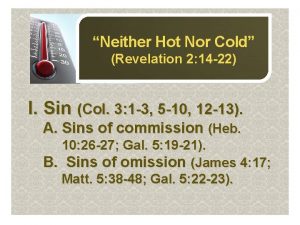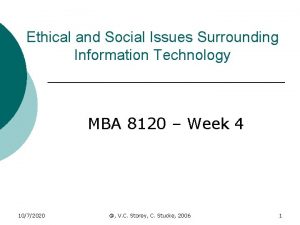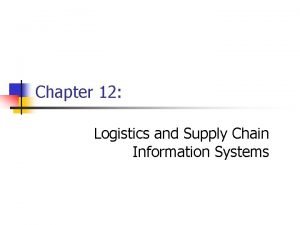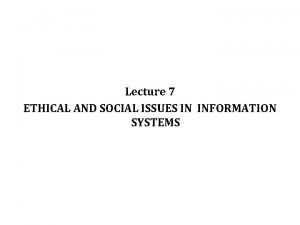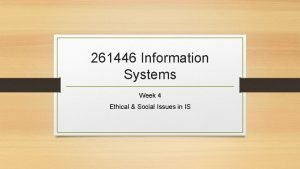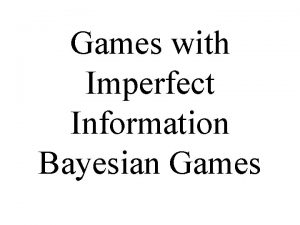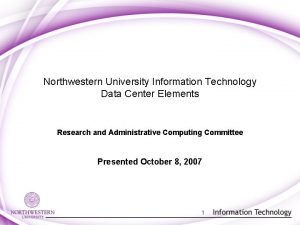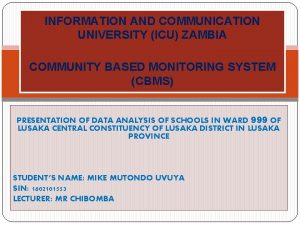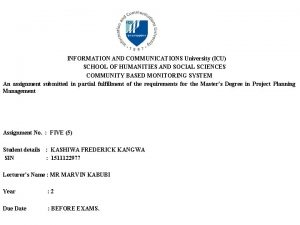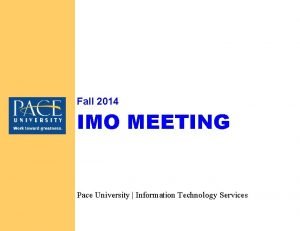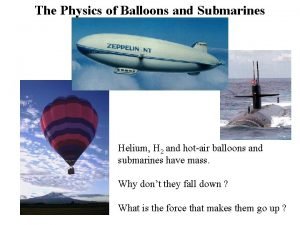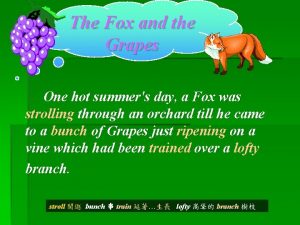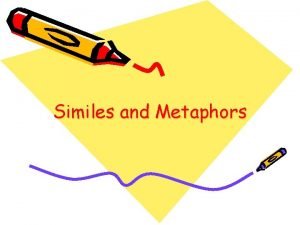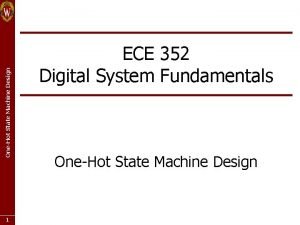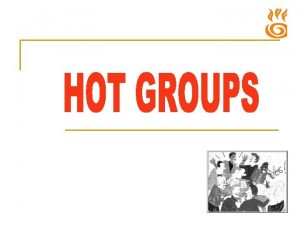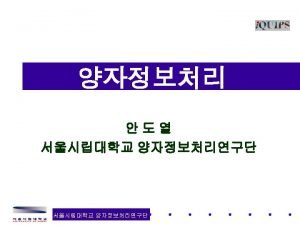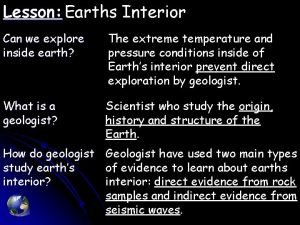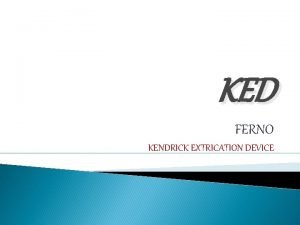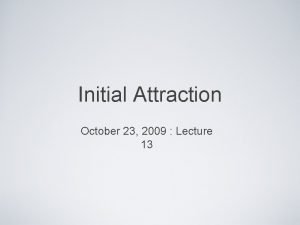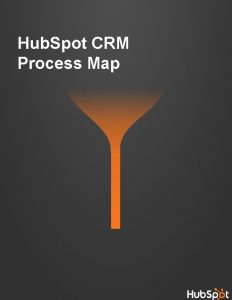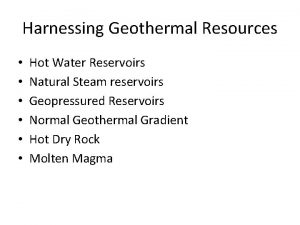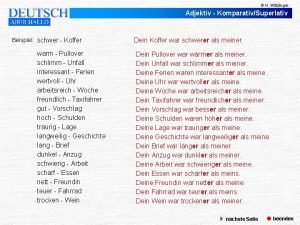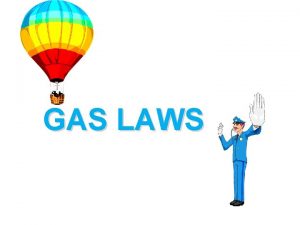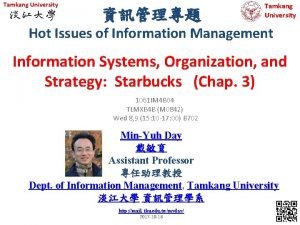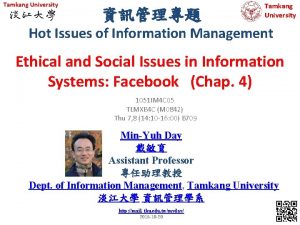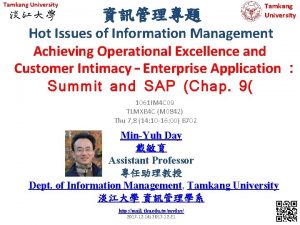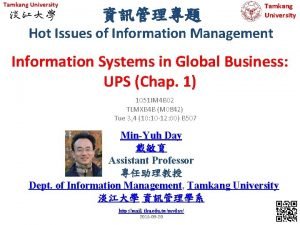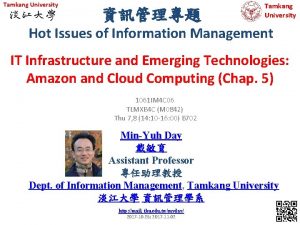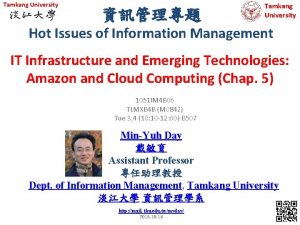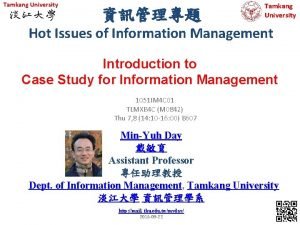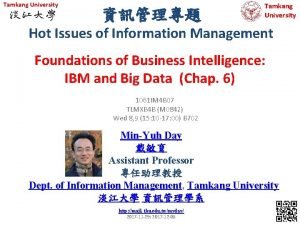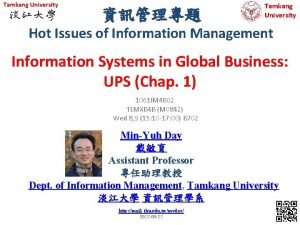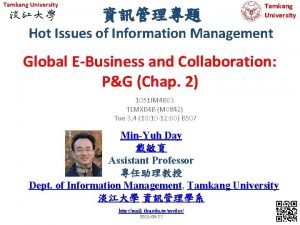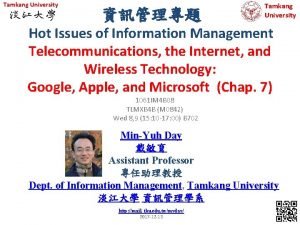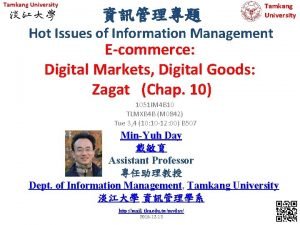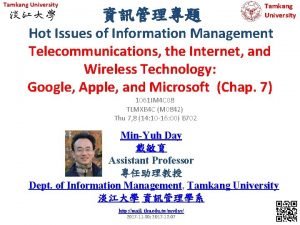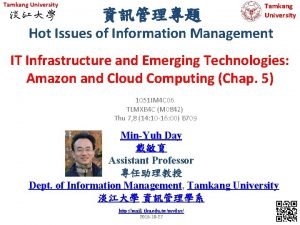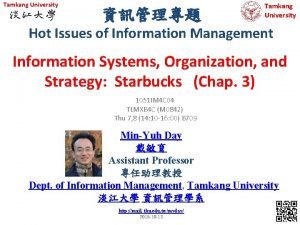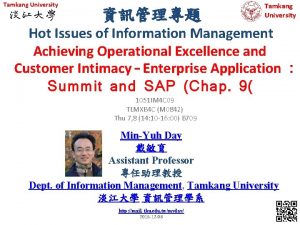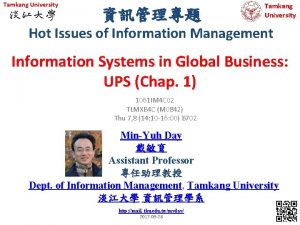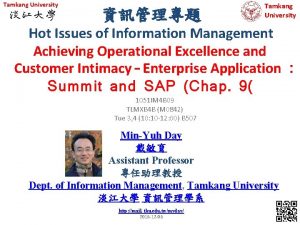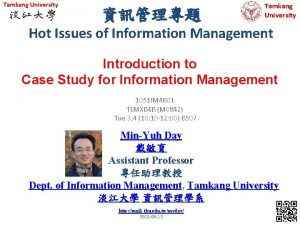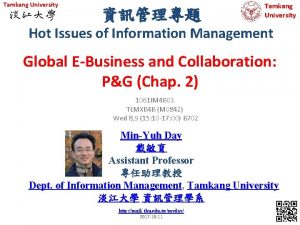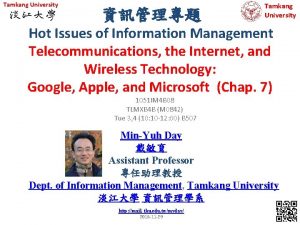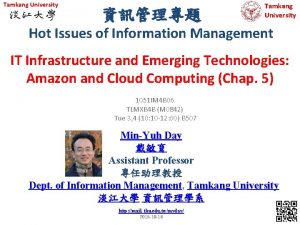Tamkang University Tamkang University Hot Issues of Information









































































- Slides: 73

Tamkang University 資訊管理專題 Tamkang University Hot Issues of Information Management Telecommunications, the Internet, and Wireless Technology: Google, Apple, and Microsoft (Chap. 7) 1051 IM 4 C 08 TLMXB 4 C (M 0842) Thu 7, 8 (14: 10 -16: 00) B 709 Min-Yuh Day 戴敏育 Assistant Professor 專任助理教授 Dept. of Information Management, Tamkang University 淡江大學 資訊管理學系 http: //mail. tku. edu. tw/myday/ 2016 -11 -24 1

課程大綱 (Syllabus) 週次 (Week) 日期 (Date) 內容 (Subject/Topics) 1 2016/09/15 中秋節 (放假一天) (Mid-Autumn Festival)(Day off) 2 2016/09/22 Introduction to Case Study for Information Management Hot Topics 3 2016/09/29 Information Systems in Global Business: UPS (Chap. 1) (pp. 53 -54) 4 2016/10/06 Global E-Business and Collaboration: P&G (Chap. 2) (pp. 84 -85) 5 2016/10/13 Information Systems, Organization, and Strategy: Starbucks (Chap. 3) (pp. 129 -130) 6 2016/10/20 Ethical and Social Issues in Information Systems: Facebook (Chap. 4) (pp. 188 -190) 2

課程大綱 (Syllabus) 週次 (Week) 日期 (Date) 內容 (Subject/Topics) 7 2016/10/27 IT Infrastructure and Emerging Technologies: Amazon and Cloud Computing (Chap. 5) (pp. 234236) 8 2016/11/03 Foundations of Business Intelligence: IBM and Big Data (Chap. 6) (pp. 261 -262) 9 2016/11/10 Midterm Report (期中報告) 10 2016/11/17 期中考試週 11 2016/11/24 Telecommunications, the Internet, and Wireless Technology: Google, Apple, and Microsoft (Chap. 7) (pp. 318 -320) 12 2016/12/01 Enterprise Applications: Summit and SAP (Chap. 9) (pp. 396 -398) 3

課程大綱 (Syllabus) 週次 日期 內容(Subject/Topics) 13 2016/12/08 E-commerce: Zagat (Chap. 10) (pp. 443 -445) 14 2016/12/15 Enhancing Decision Making: Zynga (Chap. 12) (pp. 512 -514) 15 2016/12/22 Managing Projects: NYCAPS and City. Time (Chap. 14) (pp. 586 -588) 16 2016/12/29 Final Report I (期末報告 I) 17 2017/01/05 Final Report II (期末報告 II) 18 2017/01/12 期末考試週 4

Management Information Systems: Managing the Digital Firm 1 2 3 4 Organization, Management, and the Networked Enterprise Information Technology Infrastructure Key System Applications for the Digital Age Building and Managing Systems Source: Kenneth C. Laudon & Jane P. Laudon (2014), Management Information Systems: Managing the Digital Firm, Thirteenth Edition, Pearson. 5

Chap. 7 Telecommunications, the Internet, and Wireless Technology: Google, Apple, and Microsoft 6

Case Study: Google, Apple, and Microsoft (Chap. 7) (pp. 318 -320) Apple, Google, and Microsoft Battle for Your Internet Experience 1. Define and compare the business models and areas of strength of Apple, Google, and Microsoft. 2. Why is mobile computing so important to these three firms? Evaluate the mobile platform offerings of each firm. 3. What is the significance of applications and app stores, and closed vs. open app standards to the success or failure of mobile computing? 4. Which company and business model do you believe will prevail in this epic struggle? Explain your answer. 5. What difference would it make to a business or to an individual consumer if Apple, Google, or Microsoft dominated the Internet experience? Explain your answer. Source: Kenneth C. Laudon & Jane P. Laudon (2014), Management Information Systems: Managing the Digital Firm, Thirteenth Edition, Pearson. 7

Overview of Fundamental MIS Concepts Business Challenges Management Organization Information System Business Solutions Technology Source: Kenneth C. Laudon & Jane P. Laudon (2014), Management Information Systems: Managing the Digital Firm, Thirteenth Edition, Pearson. 8

Business Model 8 6 2 4 Key Activities Key Partners 7 Customer Relationships Value Proposition Key Resources 9 Cost Structure 1 Customer Segments 3 Channels 5 Revenue Streams Source: Alexander Osterwalder & Yves Pigneur, Business Model Generation: A Handbook for Visionaries, Game Changers, and Challengers, Wiley, 2010. 9

Understanding Business Model • Revenue Model • Business Strategy and Information System Alignment 10

Business Model 11

Value 12

Definition of Business Model A business model describes the rationale of how an organization creates, delivers, and captures value. Source: Alexander Osterwalder & Yves Pigneur, Business Model Generation: A Handbook for Visionaries, Game Changers, and Challengers, Wiley, 2010. 13

E-commerce Business Models 1. 2. 3. 4. 5. 6. 7. Portal E-tailer Content Provider Transaction Broker Market Creator Service Provider Community Provider Source: Kenneth C. Laudon & Jane P. Laudon (2012), Management Information Systems: Managing the Digital Firm, Twelfth Edition, Pearson. 14

E-commerce Revenue Models 1. 2. 3. 4. 5. 6. Advertising Sales Subscription Free/Freemium Transaction Fee Affiliate Source: Kenneth C. Laudon & Jane P. Laudon (2012), Management Information Systems: Managing the Digital Firm, Twelfth Edition, Pearson. 15

Types of E-commerce 1. Business-to-consumer (B 2 C) 2. Business-to-business (B 2 B) 3. Consumer-to-consumer (C 2 C) 4. Mobile commerce (m-commerce) Source: Kenneth C. Laudon & Jane P. Laudon (2012), Management Information Systems: Managing the Digital Firm, Twelfth Edition, Pearson. 16

Business Model Canvas Key Activities Key Partners Customer Relationships Value Preposition Customer Segments Key Resources Channels Cost Structure Revenue Streams Source: http: //nonlinearthinking. typepad. com/nonlinear_thinking/2008/07/the-business-model-canvas. html https: //www. youtube. com/watch? v=Qo. AOz. MTLP 5 s 17

Business Model Canvas Infrastructure Management Key Activities Key Partners Financial Aspects Product Customer Relationships Value Preposition Customer Interface Customer Segments Key Resources Channels Cost Structure Revenue Streams Source: http: //nonlinearthinking. typepad. com/nonlinear_thinking/2008/07/the-business-model-canvas. html https: //www. youtube. com/watch? v=Qo. AOz. MTLP 5 s 18

Business Model Canvas Explained Source: http: //www. youtube. com/watch? v=Qo. AOz. MTLP 5 s 19

The 9 Building Blocks of Business Model 8 6 7 9 2 4 1 3 5 Source: Alexander Osterwalder & Yves Pigneur, Business Model Generation: A Handbook for Visionaries, Game Changers, and Challengers, Wiley, 2010. 20

The 9 Building Blocks of Business Model Source: Alexander Osterwalder & Yves Pigneur, Business Model Generation: A Handbook for Visionaries, Game Changers, and Challengers, Wiley, 2010. 21

The 9 Building Blocks of Business Model 1. Customer Segments – An organization serves one or several Customer Segments. 2. Value Propositions – It seeks to solve customer problems and satisfy customer needs with value propositions. 3. Channels – Value propositions are delivered to customers through communication, distribution, and sales Channels. 4. Customer Relationships – Customer relationships are established and maintained with each Customer Segment. Source: Alexander Osterwalder & Yves Pigneur, Business Model Generation: A Handbook for Visionaries, Game Changers, and Challengers, Wiley, 2010. 22

The 9 Building Blocks of Business Model 5. Revenue Streams – Revenue streams result from value propositions successfully offered to customers. 6. Key Resources – Key resources are the assets required to offer and deliver the previously described elements… 7. Key Activities – …by performing a number of Key Activities. 8. Key Partnerships – Some activities are outsourced and some resources are acquired outside the enterprise. 9. Cost Structure – The business model elements result in the cost structure. Source: Alexander Osterwalder & Yves Pigneur, Business Model Generation: A Handbook for Visionaries, Game Changers, and Challengers, Wiley, 2010. 23

Business Model 8 6 2 4 Key Activities Key Partners 7 Customer Relationships Value Proposition Key Resources 9 Cost Structure 1 Customer Segments 3 Channels 5 Revenue Streams Source: Alexander Osterwalder & Yves Pigneur, Business Model Generation: A Handbook for Visionaries, Game Changers, and Challengers, Wiley, 2010. 24

Business Model Generation Source: Alexander Osterwalder & Yves Pigneur, Business Model Generation: A Handbook for Visionaries, Game Changers, and Challengers, Wiley, 2010. 25

Business Model Generation Source: Alexander Osterwalder & Yves Pigneur, Business Model Generation: A Handbook for Visionaries, Game Changers, and Challengers, Wiley, 2010. 26

Source: Alexander Osterwalder & Yves Pigneur, Business Model Generation: A Handbook for Visionaries, Game Changers, and Challengers, Wiley, 2010. 27

Source: http: //bmimatters. com/tag/business-model-canvas-examples/ 28

Source: http: //bmimatters. com/tag/business-model-canvas-examples/ 29

Source: http: //bmimatters. com/tag/business-model-canvas-examples/ 30

Source: http: //bmimatters. com/tag/business-model-canvas-examples/ 31

Source: http: //bmimatters. com/tag/business-model-canvas-examples/ 32

Source: http: //bmimatters. com/tag/business-model-canvas-examples/ 33

Source: http: //businessmodelcombo. wordpress. com/2011/02/04/what-would-a-sustainable-techno-cake-business-model-look-like/ 34 34

Customer Value Source: Philip Kotler & Kevin Lane Keller, Marketing Management, 14 th ed. , Pearson, 2012 35

Marketing “Meeting needs profitably” Source: Philip Kotler & Kevin Lane Keller, Marketing Management, 14 th ed. , Pearson, 2012 36

Value the sum of the tangible and intangible benefits and costs Source: Philip Kotler & Kevin Lane Keller, Marketing Management, 14 th ed. , Pearson, 2012 37

Value Total customer benefit Customer perceived value Total customer cost Source: Philip Kotler & Kevin Lane Keller, Marketing Management, 14 th ed. , Pearson, 2012 38

Customer Value Triad Quality, Service, and Price (qsp) Quality Service Price Source: Philip Kotler & Kevin Lane Keller, Marketing Management, 14 th ed. , Pearson, 2012 39

Value and Satisfaction • Marketing – identification, creation, communication, delivery, and monitoring of customer value. • Satisfaction – a person’s judgment of a product’s perceived performance in relationship to expectations Source: Philip Kotler & Kevin Lane Keller, Marketing Management, 14 th ed. , Pearson, 2012 40

Building Customer Value, Satisfaction, and Loyalty Source: Philip Kotler & Kevin Lane Keller, Marketing Management, 14 th ed. , Pearson, 2012 41

Customer Perceived Value Product benefit Services benefit Personnel benefit Total customer benefit Customer perceived Image benefit value Monetary cost Total customer Time cost Energy cost Psychological cost Source: Philip Kotler & Kevin Lane Keller, Marketing Management, 14 th ed. , Pearson, 2012 42

Satisfaction “a person’s feelings of pleasure or disappointment that result from comparing a product’s perceived performance (or outcome) to expectations” Source: Philip Kotler & Kevin Lane Keller, Marketing Management, 14 th ed. , Pearson, 2012 43

Loyalty “a deeply held commitment to rebuy or repatronize a preferred product or service in the future despite situational influences and marketing efforts having the potential to cause switching behavior. ” Source: Philip Kotler & Kevin Lane Keller, Marketing Management, 14 th ed. , Pearson, 2012 44

Customer Perceived Value, Customer Satisfaction, and Loyalty Customer Perceived Performance Customer Perceived Value Customer Satisfaction Customer Loyalty Customer Expectations Source: Philip Kotler & Kevin Lane Keller, Marketing Management, 14 th ed. , Pearson, 2012 45

CEO CIO CFO CEO Strategy and Sales (Leading) CIO Enterprise Technology Integration CFO-COO Finance and Operations (Lagging) Source: http: //www. r 3 now. com/what-is-the-proper-relationship-for-the-cio-ceo-and-cfo/ 46

CEO CIO CMO CEO Strategy and Sales (Leading) CIO Enterprise Technology Integration CMO Marketing Communication Adapted from: http: //www. r 3 now. com/what-is-the-proper-relationship-for-the-cio-ceo-and-cfo/ 47

CEO CIO CMO Vision Strategy CEO Mission CIO Tactics CMO Goals Objectives Operations Tasks Adapted from: http: //www. argowiki. com/index. php? title=The_Relationship_Between_the_CEO_and_CIO 48

Nothing is so practical as a good theory Source: Backer & Saren (2009), Marketing Theory: A Student Text, 2 nd Edition, Sage 49

Components of a Simple Computer Network Source: Kenneth C. Laudon & Jane P. Laudon (2014), Management Information Systems: Managing the Digital Firm, Thirteenth Edition, Pearson. 50

Corporate Network Infrastructure Source: Kenneth C. Laudon & Jane P. Laudon (2014), Management Information Systems: Managing the Digital Firm, Thirteenth Edition, Pearson. 51

Packet-Switched Networks and Packet Communications Source: Kenneth C. Laudon & Jane P. Laudon (2014), Management Information Systems: Managing the Digital Firm, Thirteenth Edition, Pearson. 52

The Transmission Control Protocol/Internet Protocol (TCP/IP) Reference Model Source: Kenneth C. Laudon & Jane P. Laudon (2014), Management Information Systems: Managing the Digital Firm, Thirteenth Edition, Pearson. 53

Functions of the Modem Source: Kenneth C. Laudon & Jane P. Laudon (2014), Management Information Systems: Managing the Digital Firm, Thirteenth Edition, Pearson. 54

The Domain Name System Source: Kenneth C. Laudon & Jane P. Laudon (2014), Management Information Systems: Managing the Digital Firm, Thirteenth Edition, Pearson. 55

Internet Network Architecture Source: Kenneth C. Laudon & Jane P. Laudon (2014), Management Information Systems: Managing the Digital Firm, Thirteenth Edition, Pearson. 56

Client/Server Computing on the Internet Source: Kenneth C. Laudon & Jane P. Laudon (2014), Management Information Systems: Managing the Digital Firm, Thirteenth Edition, Pearson. 57

How Voice over IP Works Source: Kenneth C. Laudon & Jane P. Laudon (2014), Management Information Systems: Managing the Digital Firm, Thirteenth Edition, Pearson. 58

A Virtual Private Network Using the Internet Source: Kenneth C. Laudon & Jane P. Laudon (2014), Management Information Systems: Managing the Digital Firm, Thirteenth Edition, Pearson. 59

The Global Internet • Search engines – Started as simpler programs using keyword indexes – Google improved indexing and created page ranking system • Mobile search: 20% of all searches in 2012 • Search engine marketing – Major source of Internet advertising revenue • Search engine optimization (SEO) – Adjusting Web site and traffic to improve rankings in search engine results Source: Kenneth C. Laudon & Jane P. Laudon (2014), Management Information Systems: Managing the Digital Firm, Thirteenth Edition, Pearson. 60

The Global Internet • Social search – Google +1, Facebook Like • Semantic search – Anticipating what users are looking for rather than simply returning millions of links • Intelligent agent shopping bots – Use intelligent agent software for searching Internet for shopping information Source: Kenneth C. Laudon & Jane P. Laudon (2014), Management Information Systems: Managing the Digital Firm, Thirteenth Edition, Pearson. 61

Top U. S. Web Search Engines Source: Kenneth C. Laudon & Jane P. Laudon (2014), Management Information Systems: Managing the Digital Firm, Thirteenth Edition, Pearson. 62

How Google Works Source: Kenneth C. Laudon & Jane P. Laudon (2014), Management Information Systems: Managing the Digital Firm, Thirteenth Edition, Pearson. 63

Web 2. 0 • Second-generation services • Enabling collaboration, sharing information, and creating new services online • Features – Interactivity – Real-time user control – Social participation (sharing) – User-generated content Source: Kenneth C. Laudon & Jane P. Laudon (2014), Management Information Systems: Managing the Digital Firm, Thirteenth Edition, Pearson. 64

Web 2. 0 services and tools • Blogs: chronological, informal Web sites created by individuals – RSS (Really Simple Syndication): syndicates Web content so aggregator software can pull content for use in another setting or viewing later – Blogosphere – Microblogging • Wikis: collaborative Web sites where visitors can add, delete, or modify content on the site • Social networking sites: enable users to build communities of friends and share information Source: Kenneth C. Laudon & Jane P. Laudon (2014), Management Information Systems: Managing the Digital Firm, Thirteenth Edition, Pearson. 65

Web 3. 0: The “Semantic Web” • A collaborative effort led by W 3 C to add layer of meaning to the existing Web • Goal is to reduce human effort in searching for and processing information • Making Web more “intelligent” and intuitive • Increased communication and synchronization with computing devices, communities • “Web of things” • Increased cloud computing, mobile computing Source: Kenneth C. Laudon & Jane P. Laudon (2014), Management Information Systems: Managing the Digital Firm, Thirteenth Edition, Pearson. 66

A Bluetooth Network (PAN) Source: Kenneth C. Laudon & Jane P. Laudon (2014), Management Information Systems: Managing the Digital Firm, Thirteenth Edition, Pearson. 67

An 802. 11 Wireless LAN Source: Kenneth C. Laudon & Jane P. Laudon (2014), Management Information Systems: Managing the Digital Firm, Thirteenth Edition, Pearson. 68

How RFID Works Source: Kenneth C. Laudon & Jane P. Laudon (2014), Management Information Systems: Managing the Digital Firm, Thirteenth Edition, Pearson. 69

A Wireless Sensor Network Source: Kenneth C. Laudon & Jane P. Laudon (2014), Management Information Systems: Managing the Digital Firm, Thirteenth Edition, Pearson. 70

Case Study: Summit and SAP (Chap. 9) (pp. 396 -398) Summit Electric Lights Up with a New ERP System 1. Which business processes are the most important at Summit Electric Supply? Why? 2. What problems did Summit have with its old systems? What was the business impact of those problems? 3. How did Summit’s ERP system improve operational efficiency and decision making? Give several examples. 4. Describe two ways in which Summit’s customers benefit from the new ERP system. 5. Diagram Summit’s old and new process for handling chargebacks. Source: Kenneth C. Laudon & Jane P. Laudon (2014), Management Information Systems: Managing the Digital Firm, Thirteenth Edition, Pearson. 71


References – Kenneth C. Laudon & Jane P. Laudon (2014), Management Information Systems: Managing the Digital Firm, Thirteenth Edition, Pearson. – Kenneth C. Laudon & Jane P. Laudon原著, 游張松 主編,陳文生 翻譯 (2014), 資訊管理系統,第 13版,滄海 73
 White hot vs red hot temperature
White hot vs red hot temperature Cold working and hot working
Cold working and hot working Perbedaan hot lava dan hot lava volcano
Perbedaan hot lava dan hot lava volcano Hot nor
Hot nor Legal and ethical issues in computer security
Legal and ethical issues in computer security Social issues in information technology
Social issues in information technology Ethical and social issues in the digital firm
Ethical and social issues in the digital firm Ethical and social issues in information systems doc
Ethical and social issues in information systems doc Legal, ethical and societal issues in media and information
Legal, ethical and societal issues in media and information Chapter 4 ethical issues
Chapter 4 ethical issues Contemporary issues in information systems
Contemporary issues in information systems Information about social issues
Information about social issues Social issues in technology management
Social issues in technology management Legal and ethical issues in information security
Legal and ethical issues in information security Chapter 4 ethical and social issues in information systems
Chapter 4 ethical and social issues in information systems Ethical and social issues in information systems
Ethical and social issues in information systems Imperfect vs incomplete information
Imperfect vs incomplete information Northwestern university information technology
Northwestern university information technology Icu zambia assignments
Icu zambia assignments Tashkent university of information technologies
Tashkent university of information technologies Department of information engineering university of padova
Department of information engineering university of padova Department of information engineering university of padova
Department of information engineering university of padova List of lecturers at icu zambia
List of lecturers at icu zambia Pace university information technology
Pace university information technology 沈榮麟
沈榮麟 Hot pack kontrendikasyonları
Hot pack kontrendikasyonları Xxxxx hot
Xxxxx hot Hot air oven drawing with label
Hot air oven drawing with label Why is las vegas so hot
Why is las vegas so hot Difference between filling and spread
Difference between filling and spread Osha hot work
Osha hot work Coil visbreaking
Coil visbreaking Erdes hot
Erdes hot What keeps the sun hot
What keeps the sun hot Balloons
Balloons What is the theme of the fox and the grapes
What is the theme of the fox and the grapes Hot 3257 tanker
Hot 3257 tanker In the japanese game show sushi roulette
In the japanese game show sushi roulette Http://explorelearning.com
Http://explorelearning.com Brianna jordan hot
Brianna jordan hot Sun is a star
Sun is a star Winter metaphor poems
Winter metaphor poems Cold war hot spots
Cold war hot spots Words with the root mort
Words with the root mort Psych weakness
Psych weakness Prepares frozen and cold desserts
Prepares frozen and cold desserts Petazl paragraph
Petazl paragraph Ece 352
Ece 352 Hot group
Hot group Given δpqr and δstu, what is m∠q?
Given δpqr and δstu, what is m∠q? Hot carrier 효과
Hot carrier 효과 Learning outcomes of empathy
Learning outcomes of empathy Why is the inside of the earth hot
Why is the inside of the earth hot True or false hot glass looks the same as cold glass.
True or false hot glass looks the same as cold glass. Susunan makanan kontinental
Susunan makanan kontinental Apa yang dimaksud kitchen
Apa yang dimaksud kitchen Ked strap order
Ked strap order Cold applied wax casing filler
Cold applied wax casing filler Hot or not composite images
Hot or not composite images Hungry
Hungry Hot spot crm
Hot spot crm Current topics in sports nutrition
Current topics in sports nutrition Hotshot dispatching service
Hotshot dispatching service Hot semi arid grassland
Hot semi arid grassland Hot semi arid grassland
Hot semi arid grassland Hot fuzz analysis
Hot fuzz analysis Hot fuzz opening scene
Hot fuzz opening scene Hot and cold definition
Hot and cold definition Hot and cold world map
Hot and cold world map Hot dessert dihidangkan pada suhu …. *
Hot dessert dihidangkan pada suhu …. * Natural steam reservoirs
Natural steam reservoirs Komparativ warm
Komparativ warm Pivnert
Pivnert Fluidoterapi endikasyonları
Fluidoterapi endikasyonları



